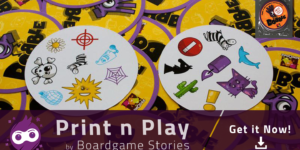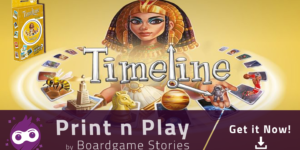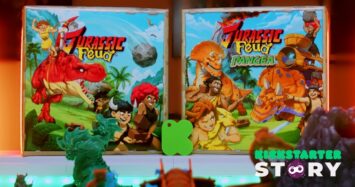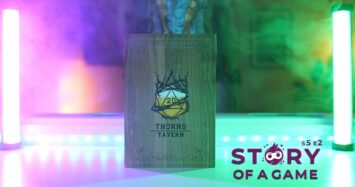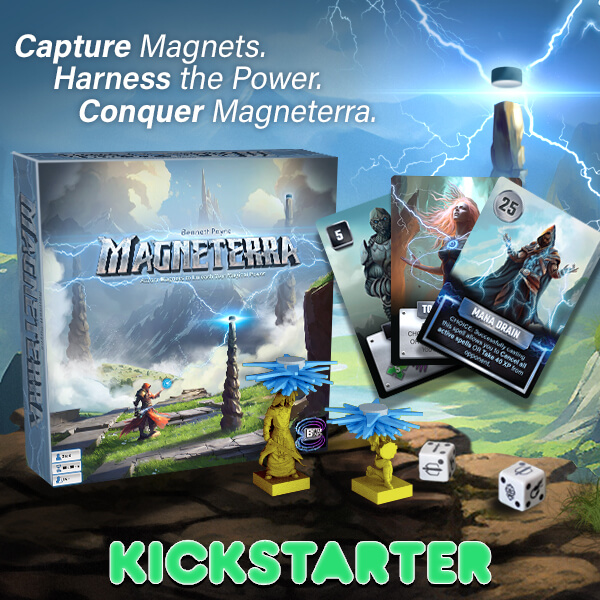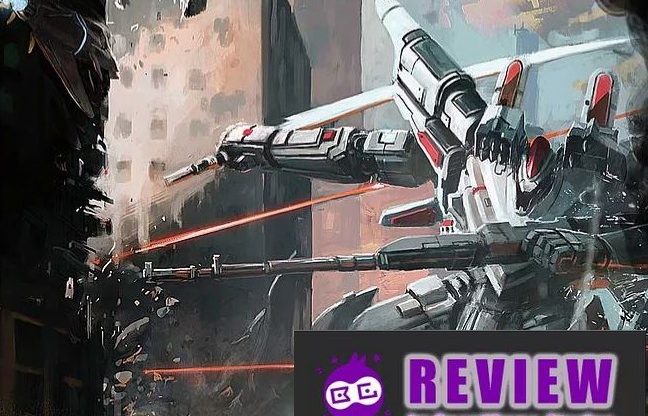
Mech Command RTS
“I set out to create the contradiction of a fast and fun board game that was strategically deep. Real time strategy video games often embodied this for us so that is why I focused on designing real time mechanics into a board game. As a fan of old school tactical RPG’s I also wanted to add the sense of context that comes from character growth over the course of a campaign. I really hope the final result will create some great board game memories for the players; which is really our ultimate goal. If we succeeded, it was because our extremely positive backer community made it possible with their patience and constant support.”
– Chris Gabrielson, Creator of Mech Command RTS
Mech Command RTS is a tabletop game produced by Bad Crow Games. The game has two teams containing a pair of mechs with support teams on opposing sides of the same campaign of missions. By deploying for the mission and achieving its objectives, the teams earn credits to upgrade their equipment for the next deployment. The game features a “real time” style mechanic with pausing periods in between for desk checking, and an entirely three dimensional setup including mech minis and buildings.
If you would like to jump to the scores, they’re towards the bottom. But if you want to really get under the hood of this game, keep reading.
There are expansions to this game, but this review is focusing on the core system. This reviewer is a backer to the game, but is otherwise unaffiliated.
Gameplay Summary
Mech Command RTS has a fairly complex setup. First, you must pick a figure for each of your team’s mechs and then give it arms. The rules say this is an aesthetic only, and does not reflect the unit’s abilities, so be creative. You then pick your player color. The color itself doesn’t matter, but becomes a designation during gameplay, and determines the color of the base your unit is set upon and the color of your tokens. From here, things get a little more complicated. Whether you’re going by a mission layout from the campaign book or making it up, place any applicable buildings and tokens on the board. This is followed by selecting your mechs’ equipment. For the very first mission of a campaign or as a tutorial, the actual mech chassis and starting equipment is predetermined – just flip through your team’s armory deck to find them. Otherwise your campaign log will list the equipment in your possession, or you will have credits to buy things from the armory deck. Once you are ready, your team (featuring your two mech loadouts, and possibly some support trucks) begins in pre-designated base hexes, which are in the corners of the board. There’s a primary and secondary base for each team that are visible by shaded hexes. Now grab the right amount of energy and ammo tokens based on your chassis, and get to work.
Actual gameplay has three phases: Action, Damage, Repair/Recharge. In the “Action” phase, a timer is set for two minutes (an hourglass is included) and players may start doing things. To move, a player takes one of their energy tokens and places it on the mech card, and (with the same hand) moves their mech one hex, facing any direction they like. Beyond that, the energy and ammo are spent based on the equipment. A player announces an attack by saying their color hits the target mech’s color (e.g. “Blue hits Red”). The timer is paused, and then the attacking player checks to see if the light on their mech’s base shines on their target. If the defender wants and is able to, they may activate their boosters at this point to avoid the attack.
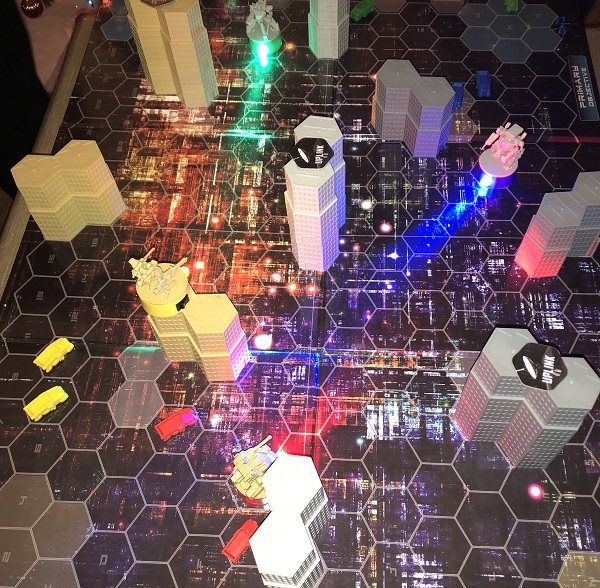
Gameplay in progress
Activating a piece of equipment has a cost denoted on the top left of its card. Some weapons use ammo, but otherwise this cost is almost exclusively energy. Take unused energy/ammo tokens equal to that cost and place them on the equipment so long as the new number of tokens on the card isn’t greater than the Overheat value on the bottom right of the card. Should the target not dodge, the attacker places a number of damage tokens equal to the weapon’s damage (top right corner) into the tray of that player’s color. For now, that’s all that happens with the damage. Some weapons have a range limit, and if the distance between the attacker and the target is greater than that, then the attack outright misses. Alternatively, an attack may target a building and the damage is placed on or by that building. Enough damage destroys it and removes it from the game table. Upon concluding the attack, resume the timer.
To move, a player takes one of their energy tokens and places it on the mech card, and (with the same hand) moves their mech one hex on the same altitude or to descend, facing any direction they like. Beyond that, the energy and ammo are spent based on the equipment. Boosting doesn’t just let you avoid an attack, it is also a regular movement. Where weapons have a damage value, boosters have a movement value. You may move a number of hexes, regardless of altitude equal to this value. It’s the only way to get on top of a building.
Once all players have taken the actions they desire or are able to, or the timer runs out, the “Damage” phase starts. During the damage phase, every player has their tray returned if there are any tokens in it. They must then place them on their mech sheet, careful not to cover all of the bubbles that are connected in any one area, lest they suffer destroyed limbs and parts. One of the starting items is a shield that allows some unspent energy to absorb damage, but ultimately the goal is not to fill all of the green circles because they represent the core chassis. With the green damage circles all covered, the mech is destroyed. A leg might be destroyed, causing basic movement to cost two energy instead of one for the first leg, or completely disable non-boost movement with the second. Arm and back slot equipment are flipped over if all of the blue circles connected to it are gone. In some missions, there are respawns, allowing the unit in question to come back a number of turns later based on its weight class, promoting more aggressive combat with other objectives taking mission priority.
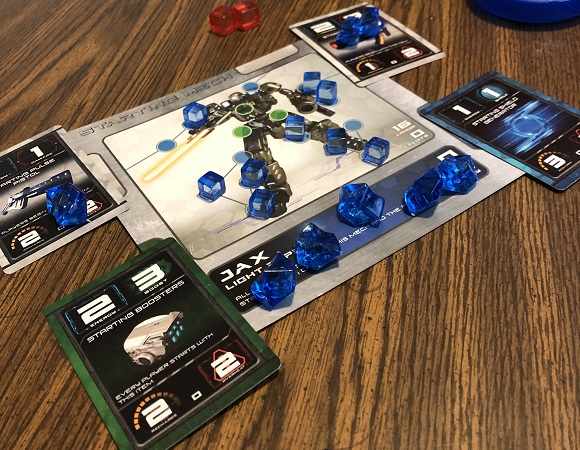
This mech has lost its left arm during the damage phase. It is the starting mech with all the starting gear.
For any remaining units, we move along to the Repair & Recharge phase. All energy spent on basic movement comes back. From there, you clear the spent ammo or regain the spent energy based on the “recharge” rate of the item. As often as not, the recharge will be less than the overheat value, permitting some equipment to be used once every two or three rounds. Ammo does not return unless the unit is in a base, where they receive two of their lost ammo, as well as two armor back. Many mission objectives are counted at this point, because your unit(s) survived long enough to claim them.
That’s it! It’s a fair amount to type, but a whole round including damage and recharge phases tends to be less than three minutes total when players get the hang of play. Lather, rinse, and repeat until the mission is concluded.
Positive Aspects
First and foremost, the art and sculpts are spot on. The buildings are very generic, but they are also designed to be modular. The actual appearance of everything is vital to the theme as well as immersion.
Next up, the rules are easy to learn. During the first game played with four players, we did everything turn-based to get people used to the economics of each round. Everyone did well to understand the core mechanics, and still had fun so we pressed on to the second mission. A new player had arrived at this point, and substituted in for someone, but the second mission in the campaign book was set up and we continued after explaining the rules. In mission two, we went to full real time with the rules fully in place. The newest player, after only about two rounds, had a full grasp of how to do things.
Following the ease of learning, is that the mechanic is unique, functional, and streamlined. There are no charts, desk checking is done in a very quick and visual way, and instead of cards or dice, your opponents choosing their actions in real time introduce the chaos element to keep things random. Granted, as a seasoned Battletech fan, none of these items are strictly a negative on their own. In the same vein, seeing another game where parts are blown off and damage matters before health is at zero makes the movements all the more tactical. It makes sense to hamper an opponent instead of allowing them to respawn at times, because it may force them to repair instead of seek goals.
The final stop is the customization of the game. A game where individual parts of a unit are swapped out, and newer isn’t always better, is refreshing. Individual items can be bought and won from the missions, and swapped out to meet the needs of a new skirmish. The game is not simply a matter of “same as last item, but +1”, which offers strategy in even the smallest change.
Winning a mission only yields nominal rewards, such as a handful of credits. Secondary rewards can be claimed by either side, and the reward for showing up to the mission in the first place is often the most substantial value. This means that losing is not necessarily a downward spiral.
Negative Aspects
While the rule book suggests some solutions, the mech chassis do not have consistently sized sockets for their arms. The arms come separate from the mechs so that they can be constructed to taste, but they frequently do not stay in. Some are sufficiently tight to hold the arms in place, the rest fall out during play. In the rules for setup, methods of adhering the arms are included, although this can easily lead to damaged components.
Much to this reviewer’s surprise, the game has a high cat hazard value. Despite being a game with a lot of movement, cats almost scattered the multitudes of counters and pieces. Equipment is easy to replace, buildings easy to place in their spots. You may lose damage and energy accounting or the positions of pieces in the process.
Earlier it was mentioned that the game is easy to learn, and its rule set complimented. Here is where it must be mentioned that players may be prone to analysis paralysis. Despite bringing in players who are comfortable with video games as tabletop RPGs, when the clock started ticking and four players were all moving pieces at once, they were overwhelmed. Their thoughts were jammed by remembering the order to take an action, only to be reset when another player did something. The turn-based test went well when they had roughly three to seven seconds to consider their options without them changing. For the most part, acclimation is to blame here, although it is a consideration when introducing the game to new players.
Lastly, this is more of a nitpick than an actual drawback: They included a sand timer to track rounds. It’s a token that everything you need is in the box, but they are prone to stopping, and if all players finish their actions before two minutes is up, they have to sit around waiting for the timer to be up. A phone was used to keep and reset time in an efficient manner. In line with component issues, the lights on the colored bases are intentionally bright to be visible across the table (the yellow light has some trouble showing by comparison to the others, especially on a tan mech) and could be a problem for people with light sensitivity, although it is key to the line of sight mechanic.
Summary
Mech Command RTS is not without its flaws, but in the hands of experienced and capable players, is quite an experience. It fits the offered theme without any stretch of imagination, and gameplay is a creative simulation of some video games. Fans of big mecha should find some satisfaction within the bounds of Mech Command. Be warned, the setup for each mission can be lengthy, some of the components may require craftsmanship to properly affix, and be willing to set time aside to train new players if you want a proper challenge.
Scores
For a refresher on our rating system, Click Here.
Set-Up Ease: 2/5
Choosing equipment and board setup can be fairly lengthy. Experienced players likely know what they want and can do it more quickly.
Gameplay Ease: 3/5
Players will have an easier time learning if they know some basics. Materials in the rule and campaign books have tutorials
Replay Value: 4/5
Different mech builds and the ability to create your own missions makes the game very flexible between plays.
Thematic: 4/5
The game’s mechanic is very immersive, and there are blurbs in the mission briefings based on past successes in the campaign. There are no “characters” to speak of, or any meaningful plot development.














